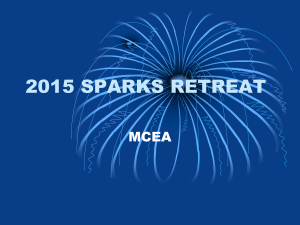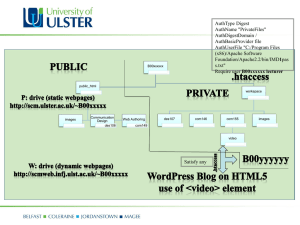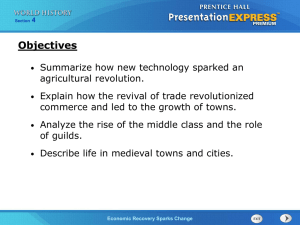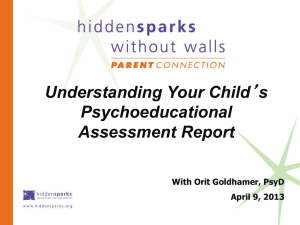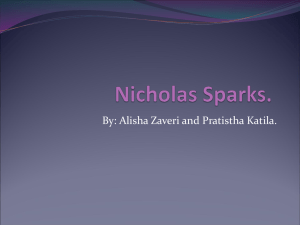Reading Comprehension
advertisement
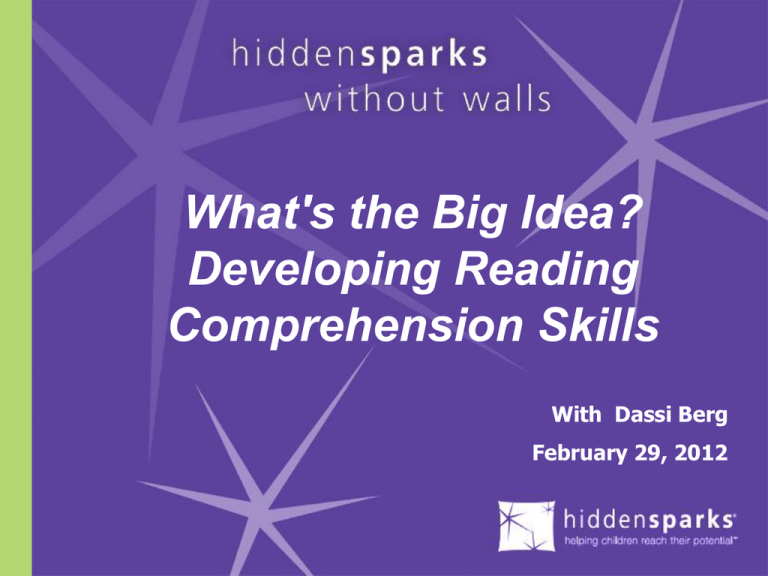
What's the Big Idea? Developing Reading Comprehension Skills With Dassi Berg February 29, 2012 Our Guest: Hadassah (Dassi) Berg, Ed.D, a literacy specialist in private practice, provides teacher training in literacy to schools and organizations. She also serves as an adjunct professor at Mercy College and as a consultant, program developer and adjunct professor at Daemen College. Previously, Dr. Berg worked in the New York City Public Schools as a special education teacher and staff developer. Dr. Berg earned her master’s degree and doctorate degree in special education from Teachers College, Columbia University, and is certified in school administration and supervision. © 2012 Hidden Sparks Overview of the Session Reading comprehension, the process of constructing meaning through active interaction with a text, is the ultimate goal of reading instruction. This webinar will focus on various areas of reading comprehension (such as predictions and prior knowledge, questioning, summarization, think-aloud, and visualization) with specific examples of strategies and techniques that may be utilized within each area. Participants will learn explicit approaches and strategies to help students develop and apply these comprehension strategies. © 2012 Hidden Sparks Session Goals: • To recognize the importance of effective reading comprehension skills • To identify six areas/categories of reading comprehension skills including: predictions and prior knowledge, questioning skills, visual representation, summarization, text structure and features, and thinkaloud • To become familiar with strategies and techniques for improving reading comprehension skills in each of the six areas identified © 2012 Hidden Sparks © 2012 Hidden Sparks Reading Comprehension: The Learning Gap © 2012 Hidden Sparks I. Predictions and Prior Knowledge Successful readers use prior knowledge and make predictions to aid comprehension in the following ways: • predict before reading and while reading • bring all types of prior knowledge to the text and speculate about what might be written in the text • compare their prior knowledge and predictions with ideas in the text • interact constantly with the text and alter their predictions as other possibilities arise through the reading • justify their predictions based on what they read © 2012 Hidden Sparks Is Prior Knowledge Necessary? A newspaper is better than a magazine, and on a seashore is a better place than a street. At first it is better to run than to walk. Also you may have to try several times. It takes some skill but it’s easy to learn. Even young children can enjoy it. Once successful, complications are minimal. Birds seldom get too close. One needs a lot of room. Rain soaks in very fast. Too many people doing the same thing can also cause problems. If there are no complications, it can be very peaceful. A rock will serve as an anchor. If things break loose from it, however, you will not get a second chance. © 2012 Hidden Sparks Accessing Prior Knowledge: KWL K W L What I Know What I Want to Know What I Learned they fly What do they eat? Insects have six legs. some of them sting How do they talk to each other? they make buzzing noises How do they sting? they crawl Why do they buzz? bugs Where do they live? © 2012 Hidden Sparks Teaching Predictions: DRTA – Directed Reading/Thinking Activity Directed Reading Thinking Activity involves teaching students to use predictions to aid comprehension in the following way: • • • • • © 2012 Hidden Sparks sample text form predictions read further in the text confirm or adjust predictions in light of new information draw conclusions and justify new predictions Sample DRTA from Tales of a Fourth Grade Nothing by Judy Blume I will never forget Friday, May tenth. It’s the most important day of my life. It didn’t start out that way. It started out ordinary. I went to school. I ate my lunch. I had gym. And then I walked home from school with Jimmy Fargo. We planned to meet at our special rock in the park as soon as we changed our clothes. When I got to my apartment I took off my jacket and hung it in the closet. I put my books on the hall table next to my mother’s purse. I went straight to my room to change my clothes and check my turtle Dribble. The first thing I noticed was my chain latch. It was unhooked. My bedroom door was open. And there was a chair smack in the middle of my doorway. I nearly tumbled over it. I ran to my dresser to check Dribble. He wasn’t there! His bowl with the rocks and water was there – but Dribble was gone. I got really scared. I thought, Maybe he died while I was in school and I didn’t know about it. So I rushed into the kitchen and hollered, “Mom… where’s Dribble?” My mother was baking something. My brother, Fudge, sat on the kitchen floor, banging pots and pans together. “Be quiet!” I yelled at Fudge. “I can’t hear anything with all that noise.” © 2012 Hidden Sparks Sample DRTA from Tales of a Fourth Grade Nothing by Judy Blume “What did you say, Peter?” my mother asked me. “I said I can’t find Dribble. Where is he?” “You mean he’s not in his bowl?” my mother asked. I shook my head. “Oh, dear!” my mother said. “I hope he’s not crawling around somewhere. You know I don’t like the way he smells. I’m going to have a look in the bedrooms. You check in here, Peter.” My mother hurried off. I looked at my brother. He was smiling. “Fudge, do you know where Dribble is?” I asked calmly. Fudge kept smiling. “Did you take him? Did you Fudge?” I asked not so calmly. Fudge giggled and covered his mouth with his hands. I yelled, “Where is he? What did you do with my turtle?” No answer from Fudge. He banged his pots and pans together again. I yanked the pots out of his hand. I tried to speak softly. “Now tell me where Dribble is. Just tell me where my turtle is. I won’t be mad if you tell me. Come on Fudge… please.” Fudge looked up at me. “In tummy,” he said. “What do you mean, in tummy?” I asked, narrowing my eyes. “Dribble in tummy!” he repeated. © 2012 Hidden Sparks Sample DRTA from Tales of a Fourth Grade Nothing by Judy Blume “What tummy?” I shouted at my brother. “This one,” Fudge said, rubbing his stomach. “Dribble in this tummy! Right here!” I decided to go along with his game. “Okay. How did he get in there, Fudge?” I asked. Fudge stood up. He jumped up and down and sang out, “I ATE HIM… ATE HIM…. ATE HIM! Then he ran out of the room. My mother came back into the kitchen. “Well, I just can’t find him anywhere,” she said. “I looked in all the dresser drawers and the bathroom cabinets and the shower and the tub and…” “Mom,” I said, shaking my head. “How could you?” “How could I what Peter?” Mom asked. “How could you let him do it?” “Let who do what, Peter?” Mom asked. “LET FUDGE EAT DRIBBLE!” I screamed. My mother started to mix whatever she was baking. “Don’t be silly, Peter,” she said. “Dribble is a turtle.” “HE ATE DRIBBLE!” I insisted. “Peter Warren Hatcher! STOP SAYING THAT!” Mom hollered. © 2012 Hidden Sparks Sample DRTA from Tales of a Fourth Grade Nothing by Judy Blume “Well, ask him. Go ahead and ask him,” I told her. Fudge was standing in the kitchen doorway with a big grin on his face. My mother picked him pu and patted his head. “Fudgie,” she said to him, “Tell Mommy where brother’s turtle is.” “In tummy,” Fudge said. “What tummy?” Mom asked. “MINE!” Fudge laughed. My mother put Fudge down on the kitchen counter where he couldn’t get away from her. “Oh, you’re fooling Mommy… right?” “No fool!” Fudge said. My mother turned very pale. “You really ate your brother’s turtle?” Big smile from Fudge. “YOU MEAN THAT YOU PUT HIM IN YOUR MOUTH AND CHEWED HIM UP….LIKE THIS?” Mom made believe she was chewing. “No,” Fudge said. A smile of relief crossed my mother’s face. “Of course you didn’t. It’s just a joke.” She put Fudge down on the floor and gave me a look. Fudge babbled. “No chew. No chew. Gulp… gulp… all gone turtle. Down Fudge’s tummy.” © 2012 Hidden Sparks II. Questions and Questioning Fluent readers strategically engage when reading by asking questions in order to: • • • • • © 2012 Hidden Sparks focus their reading delve deeper into the text clarify meaning critically reflect on what they’ve read monitor their comprehension Types of Questions • Literal questions – the information (or answer) is directly stated in the text • Inferential questions – there are clues in the text but inferences must be made • Critical questions – applying and extending the information in the text is required © 2012 Hidden Sparks Questioning Strategy: QAR – Question/Answer Relationship With the Question-Answer Relationship strategy, students are taught to identify the type of question asked, in order to more easily find the information to answer the question. There are three types of questions which students learn to identify: • Right there – the answer is directly stated in the text • Think and search – there are clues in the text, but inferences must be made • On my own – critical thinking must be used to apply and extend what is stated in the text © 2012 Hidden Sparks QAR Picture Cue Cards © 2012 Hidden Sparks III. Visual Representation £⌡▼ }Ψ♣ ↔♦ ♫▼▼ ∑ ↔ ♣ ∏ £ ⌡▼ ≠↔Ω∑♦ © 2012 Hidden Sparks Visual Representation Research demonstrates that using mental imagery during reading: • improves knowledge comprehension • improves memory • helps with monitoring reading © 2012 Hidden Sparks Developing the Ability to Visualize • Have students use the five senses to describe the mental images that words portray. • Children buddy up and take turns with the roles of describing a picture and visualizing/guessing what the picture is. • Teach visual representation as a continuum of skills: 1. Describe/draw images of concrete objects after looking at them. 2. Describe/draw images of concrete objects not shown. 3. Image and recall familiar objects or scenes. 4. Create images of events and actions. 5. Create images while listening to a story. 6. Create mental images while reading. © 2012 Hidden Sparks Sample Visual Representation from Marvin Redpost by Louis Sachar On Sunday, Waldo’s bowl was still full of food. Maybe the food had gone bad. It had been in his bowl since Wednesday night. Marvin took the bowl into the garage and dumped it into Mrs. North’s garbage can. He returned to the kitchen. He found some green dish soap under the sink. He washed Waldo’s bowl. Then he rinsed it a long time so it wouldn’t taste like soap. He dried it with a dish towel, which he found in the drawer next to the sink. Waldo watched him. He filled the bowl with fresh dog food. “Here you go,” he said, setting it down in front of the old whisker-faced dog. Waldo didn’t even look at it. Marvin picked out a piece of dog food and held it in front of Waldo’s nose. “Yum, yum,” he said. © 2012 Hidden Sparks Sample Visual Representation from Marvin Redpost by Louis Sachar Waldo turned his head away. He whined. Marvin sat on the kitchen floor and stroked his back. “I tell you what,” he said. “If I eat it, will you?” The bit of dog food was still in his hand. Marvin opened his mouth wide so Waldo could see. He took the bit of dog food between his thumb and forefinger and held it inside his mouth. He was careful not to let it touch his tongue. He quickly pulled out his hand, closed his mouth, and swallowed. “Yum, delicious!” he said. The dog food was hidden in his fist. Waldo wasn’t fooled. “Okay,” said Marvin. “I’ll really eat it this time. But then you have to, too.” Waldo watched him. © 2012 Hidden Sparks Sample Visual Representation from Marvin Redpost by Louis Sachar Marvin touched the dog food with his tongue. It wasn’t horrible. It tasted a little like cereal. He bit into it. It was chewier than cereal. And a little bit gritty, like it had tiny seeds in it. He chewed and swallowed. It wasn’t gross. It wasn’t something he’d ask his mom to get for an after school snack. But it really wasn’t too bad. “Okay, your turn,” he said. Waldo whined. “Like this,” said Marvin. He crawled to Waldo’s bowl and picked out a piece of dog food with his teeth. He chewed it up and swallowed. He smiled at Waldo. “Delicious!” he said. Waldo lay his whiskered face against the floor. © 2012 Hidden Sparks IV. Summarization Summarization is essential as it aids comprehension in the following ways: • Organizes information and reduces text to essentials • Helps students focus on the main points of the text while leaving out unnecessary details • Allows deeper knowledge of what has been read © 2012 Hidden Sparks Summarization Stategy: Somebody Wanted But So © 2012 Hidden Sparks Summarization Strategy: Story Map © 2012 Hidden Sparks Summarization Strategy: Five W’s © 2012 Hidden Sparks Summarization Strategy: Sample 5 W’s © 2012 Hidden Sparks V. Text Structure and Features When students learn to identify the structure and features of the text that is presented they automatically have a framework for improved comprehension of the material. • • • • • © 2012 Hidden Sparks The most common text structures are: Problem/solution Compare/contrast Cause/effect Sequence Definitions/examples (description) Graphic Organizers for Text Structures © 2012 Hidden Sparks VI. Think-Aloud Students who think-aloud and talk through the process occurring in their heads are thinking metacognitively. They are able to think about their learning in the following ways: • Monitor their own thinking process • Adjust thinking to achieve clearer comprehension © 2012 Hidden Sparks Think-Aloud Strategies for Reading Comprehension • • • • • Go back and reread the sentence Use a placeholder instead of a tricky word Look for little words or parts of a word you know Ask, “Which part did I understand?” Ask, “Why don’t I understand this?” - Did I stop at the period/check the punctuation? - Did I skip/add a word? - Did I skip a line? - Was there a pronoun I didn’t understand? Who is talking? - Was it a word with two meanings? © 2012 Hidden Sparks Horse Story • • • • • • • • • • • • • • Common advice from knowledgeable horse trainers includes the adage, “If the horse you’re riding on dies, get off.” While this seems simple enough, in the business of education we do not always follow that advice. Indeed, we often – instead – choose from an array of alternatives in an attempt to “rectify” the situation. Some of the alternatives include: Buying a stronger whip Trying a new bit or bridle Switching riders Moving the horse to a new location Riding the horse for longer periods of time Saying things like, “This is the way we’ve ALWAYS ridden the horse.” Appointing a committee to study the horse Arranging to visit other sites where they ride the dead horse more efficiently Increasing the standards for riding dead horses Creating a test to measure our riding ability Comparing how we are riding now to how we rode ten/twenty years ago Complaining about the state of horses these days Coming up with new styles of riding Blaming the horse’s parents; the problem is so often in the breeding © 2012 Hidden Sparks Upcoming Hidden Sparks Without Walls Sessions Wednesday, March 21, 2012 Study Skills with Zippora Schuck Wednesday, May 2 , 2012 Transition to High School with Karen Kruger For more information visit: www.hiddensparks.org © 2012 Hidden Sparks About Hidden Sparks Hidden Sparks is a non-profit fund whose purpose is to help children with learning differences reach their full potential in school and life. Hidden Sparks develops and supports professional development programs for Jewish day schools to help increase understanding and support for teaching to diverse learners. Guided by a philosophy that by helping schools meet the needs of children with learning and behavioral differences, ultimately all students will benefit. Hidden Sparks’ programs combine professional development in learning and positive behavioral support, guided classroom observation and one on one coaching. The Hidden Sparks model and program is currently in 21 Jewish Day Schools/Yeshivot in New York and 7 in Boston, through a partnership with Gateways: Access to Jewish Education. © 2012 Hidden Sparks Contacting Hidden Sparks Contact Dassi Berg dasiberg@hotmail.com Contact Hidden Sparks: www.hiddensparks.org margaret@hiddensparks.org (212) 767-7707 © 2012 Hidden Sparks
